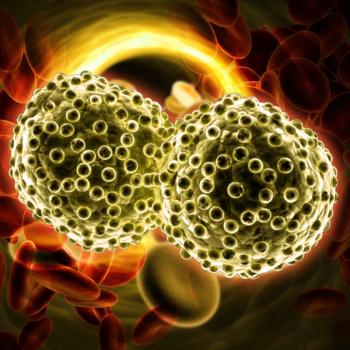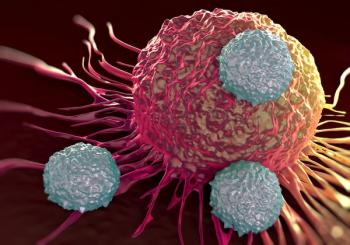
- ONCOLOGY Vol 15 No 11
- Volume 15
- Issue 11
Overview of Systemic Fungal Infections
A steady increase in the frequency of invasive fungal infections has been observed in the past 2 decades, particularly in immunosuppressed patients. In recipients of bone marrow transplants, Candida albicans and Aspergillus fumigatus remain the primary pathogens. In many centers, however, Candida species other than C albicans now predominate, and many cases of aspergillosis are due to species other than A fumigatus. Additionally, heretofore unrecognized and/or uncommon fungal pathogens are beginning to emerge, including Blastoschizomyces capitatus, Fusarium species, Malassezia furfur, and Trichosporon beigelii. These opportunistic fungal pathogens are associated with various localized and disseminated clinical syndromes, and with substantial morbidity and mortality. These established, invasive mycoses, particularly in bone marrow transplant recipients, are the focus of this discussion. [ONCOLOGY 15(Suppl 9):11-14, 2001]
ABSTRACT: A steady increase in the frequency of invasive fungal infections has been observed in the past 2 decades, particularly in immunosuppressed patients. In recipients of bone marrow transplants, Candida albicans and Aspergillus fumigatus remain the primary pathogens. In many centers, however, Candida species other than C albicans now predominate, and many cases of aspergillosis are due to species other than A fumigatus. Additionally, heretofore unrecognized and/or uncommon fungal pathogens are beginning to emerge, including Blastoschizomyces capitatus, Fusarium species, Malassezia furfur, and Trichosporon beigelii. These opportunistic fungal pathogens are associated with various localized and disseminated clinical syndromes, and with substantial morbidity and mortality. These established, invasive mycoses, particularly in bone marrow transplant recipients, are the focus of this discussion. [ONCOLOGY 15(Suppl 9):11-14, 2001]
Risk Factors and Frequency of Infection
Several risk factors account for the increased frequency of invasive fungalinfections (Table 1). Moreover, multiple risk factors may be present in the samepatient, which further increases risk. The most important risk factor for thedevelopment of fungal infection, particularly in patients with hematologicmalignancies (with or without BMT), is severe and prolonged neutropenia. Chronicgraft-vs-host disease, immunosuppressive therapy, multiple courses ofbroad-spectrum antibiotic therapy, the presence of vascular access catheters,parenteral nutrition, colonization at multiple sites, and prolonged stay in anintensive care unit are all associated with an increased frequency of invasivefungal infection. Finally, environmental exposure (hospital construction sites,contaminated cooling/heating systems) may also be a significant contributoryfactor. Prevention strategies, therefore, include the use of rooms equipped withhigh-efficiency particulate air (HEPA) filters to reduce the risk ofenvironmental exposure.[1,2]
Data from the National Nosocomial Infections Surveillance (NNIS) system havebest documented the changing epidemiology of nosocomial infections in UShospitals.[3] These data demonstrate that the rate of nosocomial fungalinfections ranges from 2.0 to 3.8 infections per 1,000 hospital discharges from1980 to 1990, with the proportion of fungal blood stream infections among allnosocomial bloodstream infections increasing from 5.4% to 9.9%.
The most marked increases occurred in surgical services (124%) and medicalservices (73%), and the rate of nosocomial candidemia increased by approximately500% in large teaching hospitals, and by 219% and 370% in small teachinghospitals and large nonteaching hospitals, respectively. It is of interest tonote that the recently reported Surveillance and Control of Pathogens ofEpidemiological Importance (SCOPE) data from 49 US hospitals indicate that Candida bloodstream infections were nearly as common in the general hospitalwards (43%) as in the intensive care unit (ICU) (57%).[4] In this survey, Candida species were the fourth most common bloodstream pathogen, accounting for7.6% of infections, with such infections being associated with a crude mortalityrate of 40%.
Spectrum of Infection
The most common yeast infection in the BMT setting (and in other neutropenicpatients) is candidiasis. Prior to the use of fluconazole prophylaxis, theincidence of invasive candidal infection was between 10% and 20%, and the mostcommon species was C albicans.[5] This has decreased substantially sincefluconazole (Diflucan), and more recently itraconazole (Sporanox), has been usedfor prophylaxis. Many studies have documented the changing epidemiology of Candida infections with decreasing isolation rates for C albicans, andincreasing isolation rates for other Candida species.[6,7]
In a study of 491 episodes of hematogenous candidiasis from the University ofTexas M. D. Anderson Cancer Center, 42% of cases were caused by C albicans, 18%by C tropicalis, 17% by C parapsilosis, 11% by C glabrata, and the rest by otherCandida species. Wide use of fluconazole appeared to be playing a major role inthis observed shift. However, a more recent survey from the same institution ofthe distribution of Candida species in pediatric patients with candidemiarevealed the same pattern (Table 2).[7,8] These patients do not receivefluconazole prophylaxis, are housed in a separate unit, and are cared for bystaff dedicated to the pediatric unit. While antifungal prophylaxisparticularlywith fluconazoleand nosocomial transmission have contributed to the changingepidemiology of infection, these data emphasize that other factors may also beinvolved.
Similarly, although A fumigatus has been the primary Aspergillus species, Aterreus and other Aspergillus species appear to be increasing in frequency.Other less common molds, including Fusarium species, the Zygomycetes, Bipolarisand other dematiaceous fungi, and the yeast Trichosporon beigelii are beingencountered with increasing frequency. The endemic mycoses (histoplasmosis,blastomycosis, cryptococcosis, coccidioidosis, etc) are seen sporadically inimmunocompromised patients.
Characteristics of Candida Infection
The clinical spectrum of candidiasis consists of local and systemicinfections. Local infections include mucocutaneous candidiasis (thrush, rectalcandidiasis), esophagitis, epiglottitis, and urinary tract infection. Amongsystemic infections, the primary problem confronted in the setting of BMT isacute (hematogenous) dissemination. Chronic systemic (hepatosplenic) candidiasisis now infrequently observed at many institutions with the widespread use offluconazole in prophylaxis and treatment.
It is clear now that what was once regarded as transient or benign candidemiaie,positive culture for Candida but no clinical indication of infection (normaltemperature, and clinical stability with no cutaneous or other distant lesionsor Candida at other sites)should be considered as neither transient norbenign. The potential for dissemination of infection in neutropenic patients insuch cases is very high, with an attributable mortality of 35% to 40%; manypatients who were labeled with transient/benign candidemia returned afterdischarge with such distant infections as hepatic or splenic disease,endophthalmitis, and osteomyelitis. Patients with candidemia often requirecatheter removal, and all require antifungal therapy.
Investigators at M. D. Anderson Cancer Center have distinguished betweenacute hematogenous candidiasis and the syndrome of chronic systemic candidiasison the basis of histopathologic findings.[9] The intestinal tract is the mostprobable focus of dissemination in acute hematogenous candidiasis, and thecommonly involved organs include kidney, liver, spleen, pancreas, eyes, skin,and skeletal muscle. Histopathology studies have shown that macroabscess ormicroabscess formation is characteristic of hematogenous candidiasis inneutropenic patients. Blood cultures are positive in approximately 50% ofpatients; specific diagnosis can be made in some cases on the basis of biopsy.
In contrast, histopathology studies of hepatic and splenic lesions in chronicsystemic candidiasis revealed that the host reaction is granuloma formation,rather than abscess formation. Although disease may be acquired duringneutropenia in cases of chronic systemic candidiasis, its manifestations,including fever, elevated alkaline phosphatase, and radiographic findings, aremuch more pronounced once recovery from neutropenia has occurred. As suggestedearlier, chronic systemic candidiasis may now be of primarily historicalsignificance; in cases in which it does occur, the ability to provide long-termtreatment after resolution of neutropenia is associated with high responserates.
One of the primary problems in the management of Candida infections inneutropenic patients is what has been termed the diagnostic paradoxie, thatapproximately 50% of patients with disseminated candidiasis do not have positiveblood cultures, while positive cultures from even multiple sites (eg, sputum,stool, urine) may not accurately reflect tissue invasion or represent systemicdisease. Radiographic imaging is useful, but positive findings usually occuronly when disease has become quite advanced. Better diagnostic techniques areneeded to improve early detection of candidiasis.
Characteristics of Aspergillus Infection
The increased frequency of aspergillosis is likely associated with anincrease in numbers of immunosuppressed patients, increasing recognition ofdisease in patients with AIDS, and more aggressive use of antineoplastic therapydesigned to produce maximal antitumor effect. In the transplantation setting,the increase is partly associated with broadened indications fortransplantation. Frequencies of aspergillosis differ among institutions; at M.D. Anderson Cancer Center, the incidence of aspergillosis among BMT patients isapproximately 10% to 15% per year.
Localized infection includes primary cutaneous infection, sinusitis,tracheobronchitis, and aspergilloma. Invasive infections include pulmonaryaspergillosis, sino-orbital aspergillosis, and disseminated infection, includingcerebral aspergillosis. Primary cutaneous aspergillosis can occur at intravenouscatheter insertion sites or in association with adhesive cutaneous dressings.Local infection is characterized by progression from local pain to erythema andblack eschar formation; histology shows invasion of local blood vessels leadingto avascular necrosis (infarction). Treatment with surgical debridement andantifungal therapy may lead to response rates better than those observed forother forms of aspergillosis.[10,11]
The paranasal sinuses are a primary focus of Aspergillus, and a frequent siteof infection in patients with prolonged neutropenia. Patients who developdisseminated aspergillosis frequently exhibit a focus in the sinuses. Localinvasion can cause fever, epistaxis, nasal discharge, and sinus pain and canresult in orbital, cerebral, pulmonary, or disseminated disease. Plainradiographs are relatively insensitive in detecting infection. Computedtomography (CT) scans show opacification, fluid collection, and, in moreadvanced infection, bone erosion.
Invasive pulmonary aspergillosis is the disease entity most frequentlyencountered in BMT patients. Clinical manifestations of such infection includefever, dyspnea, and tachypnea and chest pain, which may be pleuritic; hemoptysisand hypoxemia are occasionally observed, and a pleural friction rub may bepresent. Although radiographic findings are minimal during early infection, avariety of findings on regular radiographs and CT scans are characteristic ofinfection. These findings include pleural-based wedge-shaped lesions, nodulardensities, halo sign and cavitary lesions with an air crescent sign, and diffusebilateral infiltrates; pleural effusion is uncommon but may be hemorrhagic whenpresent. Blood cultures in patients with invasive aspergillosis are almostinvariably negative; at our institution, less than 1% to 2% of patients withdisseminated aspergillosis yield positive blood cultures, compared withapproximately 60% to 70% of patients with disseminated Fusarium infection. Thereason for this variability is poorly understood.
Emerging Fungal Pathogens
Trichosporon beigelii causes localized and disseminated disease most commonlyin patients with leukemia and prolonged neutropenia.[12] The spectrum ofinfection is similar to that seen with Candida species, and the attributablemortality rate is approximately 60% to 70%.[13] Therapy for trichosporosis issuboptimal since the polyenes lack consistent activity against these organisms.Azole antifungal drugs appear to have better activity.
Blastoschizomyces capitatus (formerly Trichosporon capitatum or Geotrichumcapitatum) is another yeast form that has been recognized as a cause ofdisseminated disease in neutropenic patients.[14]
Among the molds, Fusarium species have emerged as important pathogens inneutropenic patients and BMT recipients with chronic GVHD.[15] Fusarium solaniis the most common species and often causes invasive disease involving multiplesites such as the paranasal sinuses, lungs, skin and soft tissue, muscle, bone,kidneys, liver, spleen, and the central nervous system. The manifestations areoften indistinguishable from aspergillosis, with the exception of a much higherfrequency of cutaneous lesions and positive blood cultures (75%) with fusariosis.There is no standard or highly effective therapy for fusariosis. Reversal of theoriginal immunological deficit (neutropenia, etc), improves the chances ofrecovery.
Summary
The incidence of invasive fungal infection continues to increase and has anenormous effect on the overall survival of neutropenic and otherimmunocompromised patients. Methods for early detection, before invasive diseaseand/or dissemination occur, are vital because response to current therapeuticmodalities is suboptimal. The emergence of newer and more persistent fungalpathogens is a significant problem. The development of novel antifungal agents(newer azoles, echinocandins) and newer formulations of standard agents (lipidformulations of amphotericin B and nystatin; intravenous itraconazole) aregiving clinicians newer options, but much work remains to be done in evaluatingthese agents and establishing their role in the overall management of fungalinfections. Infection prevention, and modalities to reverse the underlyingimmunological deficit(s) or enhance the immune response, need to play a largerrole then they currently do in this difficult clinical setting.
References:
1. Dismukes WE: Established and emerging invasive mycoses. Infect Dis ClinPract 7(suppl 1):S35-S41, 1998.
2. Perfect JR, Schell WA: The new fungal opportunists are coming. Clin InfectDis 22(suppl 2):112S-118S, 1996.
3. Beck-Sague CM, Jarvis WR: The National Nosocomial Infections Surveillancesystem. Secular trends in the epidemiology of nosocomial fungal infections inthe United States, 1980-1990. J Infect Dis 167:1247-1251, 1993.
4. Edmond MB, Wallace SE, McCush DK, et al: Nosocomial bloodstream infectionsin United States hospitals: A 3-year analysis. Clin Infect Dis 29:239-244, 1999.
5. Meyers JD: Fungal infections in bone marrow transplant patients. SeminOncol 17:10-13, 1990.
6. Nguyen MH, Peacock JE Jr, Morris AJ, et al: The changing face ofcandidemia: Emergence of non-Candida albicans species and antifungal resistance.Am J Med 100:617-623, 1996.
7. Abi-Said D, Anaissie E, Uzon O, et al: The epidemiology of hematogenouscandidiasis caused by different Candida species. Clin Infect Dis 24:1122-1128,1997.
8. Samir H, Tarrand J, Rolston K: The changing face of candidiasis in apediatric population. 4th International Symposium on Febrile Neutropenia(abstract 47). Brussels, December 15-18, 1999.
9. Kontoyiannis DP, Luna MA, Samuels BI, et al: Hepatosplenic candidiasis: amanifestation of chronic disseminated candidiasis. Infect Dis Clin North Am14:721-739, 2000.
10. Khardori N, Hayat S, Rolston K, et al: Cutaneous Rhizopus and Aspergillusinfections in five cancer patients. Arch Derm 125:952-956, 1989.
11. Walsh TJ: Primary cutaneous aspergillosis: An emerging infection amongimmunocompromised patients. Clin Infect Dis 27:453-457, 1998.
12. Hoy J, Hsu K, Rolston K, et al: Trichosporon beigelii infection: Areview. Rev Infect Dis 8:959-967, 1986.
13. Walsh TJ: Trichosporinosis. Infect Dis Clin North Am 3: 43-52, 1989.
14. Martino P, Venditti M, Micozzi A, et al: Blastoschizomyces capitatus: Anemerging cause of invasive fungal disease in leukemic patients. Rev Infect Dis12:570-572, 1990.
15. Anaissie E, Kantarjian H, Ro J, et al: The emerging role of Fusariuminfections in patients with cancer. Medicine (Baltimore) 67:77-83, 1988.
Articles in this issue
about 24 years ago
Management of Pressure Ulcersabout 24 years ago
National Alliance of Breast Cancer Organizations Relaunches Websiteabout 24 years ago
Color Atlas of Clinical Hematology, Third Editionabout 24 years ago
FDA Approves Capecitabine Plus Docetaxel for Metastatic Breast Cancerabout 24 years ago
Survey Finds Women Unwilling to Pay for Immediate Mammography ResultsNewsletter
Stay up to date on recent advances in the multidisciplinary approach to cancer.































































































